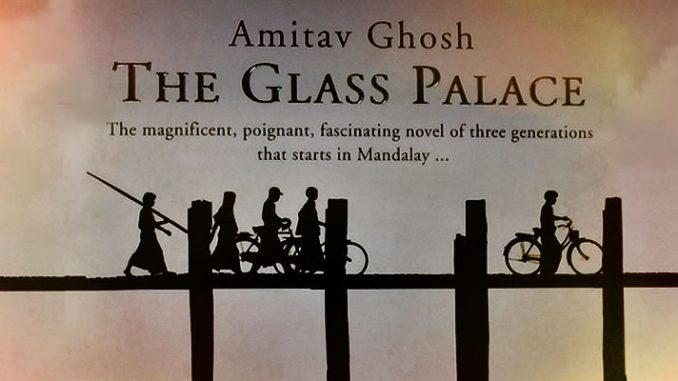THE
GLASS PALACE
The Glass Palace (2001) by leading Indian author Amitav Gosh is a historical
novel and family saga that looks at the creation of contemporary Myanmar
(formerly known as Burma) through two families, one Burmese royalty, the other
Indian. It extends a period of 115 years. Along with mass critical
acclaim, The Glass Palace has
been translated into 25 languages.
Its themes include colonialism, heartbreak, and personal
grit. The historical novel is divided into seven parts.
While The Glass Palace has hundreds of characters, one
of its main protagonists is an 11 year old orphan boy named Rajkumar; he is a
refugee from India with an entrepreneurial drive and a romantic heart. The
novels opens to a scene of British cannons going off in the suburbs of Mandalay,
the capital of what was called Burma, right before the English invasion of
1885. While Rajkumar overheard some speculation that the British were unhappy
with trade deals proposed by Burma’s king, King Thebaw, no one actually thought
that was reason enough to go to war.
Rajkumar is the only person quick-witted enough to know
that the city is under siege. He found work as an assistant food seller to Ma
Cho, a bright and gruff (but also kind) woman who is a distant friend of his
family’s. The two hide their wares and prepare for the invasion.
When the British
invade Mandalay in 1885, the royal family goes into exile in India. With the
glass palace empty, thousands of people stream through its hallowed halls to
loot everything that isn’t nailed down; this includes its highly valuable
crystals and mirrors, which will be sold on the black market later. It’s during
this chaotic moment that Rajkumar catches a glimpse of the 10-year-old Dolly,
who is a beautiful girl and the queen’s favorite servant. He falls in love with
her instantly.
The two have a brief
talk, then promise to find each other again, someday. He vows one day to make
enough money so that she will marry him. As the years progress and Rajkumar
becomes a successful businessman, he will think of Dolly and push himself
toward greater success for the chance to be reunited with her.
Rajkumar learns about
the teak fine-furniture business through Saya John, a personable man. from East
Asia who Ma Cho periodically took as a lover. Saya John tells Rajkumar all
about teak, a type of plant used to wood; teak is highly valuable for its
polished appearance.
The narrative then
switches to detailing the exiled family’s life in Ratnagiri, a small fishing
village in the suburbs of Bombay (currently called Mumbai). Queen Supayalt is
increasingly frustrated with her thwarted life; the family has to ration their
resources and she has lost all of
her social prestige. She frequently takes her anger out on the help.
her social prestige. She frequently takes her anger out on the help.
But not all of the
family shares her distress. King Thebaw, while initially distraught, ends up
making the most of his new living situation under British powers. He and his
family become prominent figures in these village, and they all gain some peace
in exile.
Political life in
Ratagiri does become heated after an ambitious Collector (a high-powered
administrator from the British-Indian government) moves into town and starts
bossing everyone else around. Some of his actions infuriate Dolly, but Uma—the
Collector’s wife—apologizes for her husband’s bullying behavior, and lets Dolly
know that she’s sympathetic toward the Indian movement for independence.
Meanwhile Rajkumar,
now in his late 20s, has advanced his career by transporting teak with
elephants, and entering oil drilling operations in Burma. Eventually, he earns
enough money to found a private lumber mill. His friend and business partner,
Doh Say, helps him run the lumber mill.
With enough money in
the bank, Rajkumar hires a private investigator to find Dolly. They are both in
their early 40s. He finds out that she is now employed at the house of Uma and
the Collector. He dines there, sees Dolly working there, and after some brief
romances, asking her to move back with him to Burma, which was now called
British Malaya.
Rajkumar and Dolly
have two children: Neel and Dinu. Rajkumar’s several teak enterprises flourish.
He becomes one of the world’s top stationary producers through his lumber mill.
He tries not to think about his collaboration with British rule.
After some sage advice from Saya John, Rajkumar makes the
most of the burgeoning rubber industry during WW1. He becomes an even wealthier
man.
In WWII, the mid-Asian countries unite against a
belligerent Japan. Rajkumar’s business doesn’t fare as well as it did in WWI.
When Japan invades British Malaya, they show no mercy on local businesses, and
seize all of Rajukumar’s assets. The family is effectively ruined.
After much war, death,
and family separation, the novel concludes in 1996 during strikes from the
rubber plantation workers that Rajkumar (long ago deceased) once employed. Aung
San Suu Kyi, who won the Nobel Peace Prize in 1990, would remain under house
arrest from 1988 to 2010. By describing her in-depth, the author conveys his
hope for the future of Burma/Myanmar.




Comments